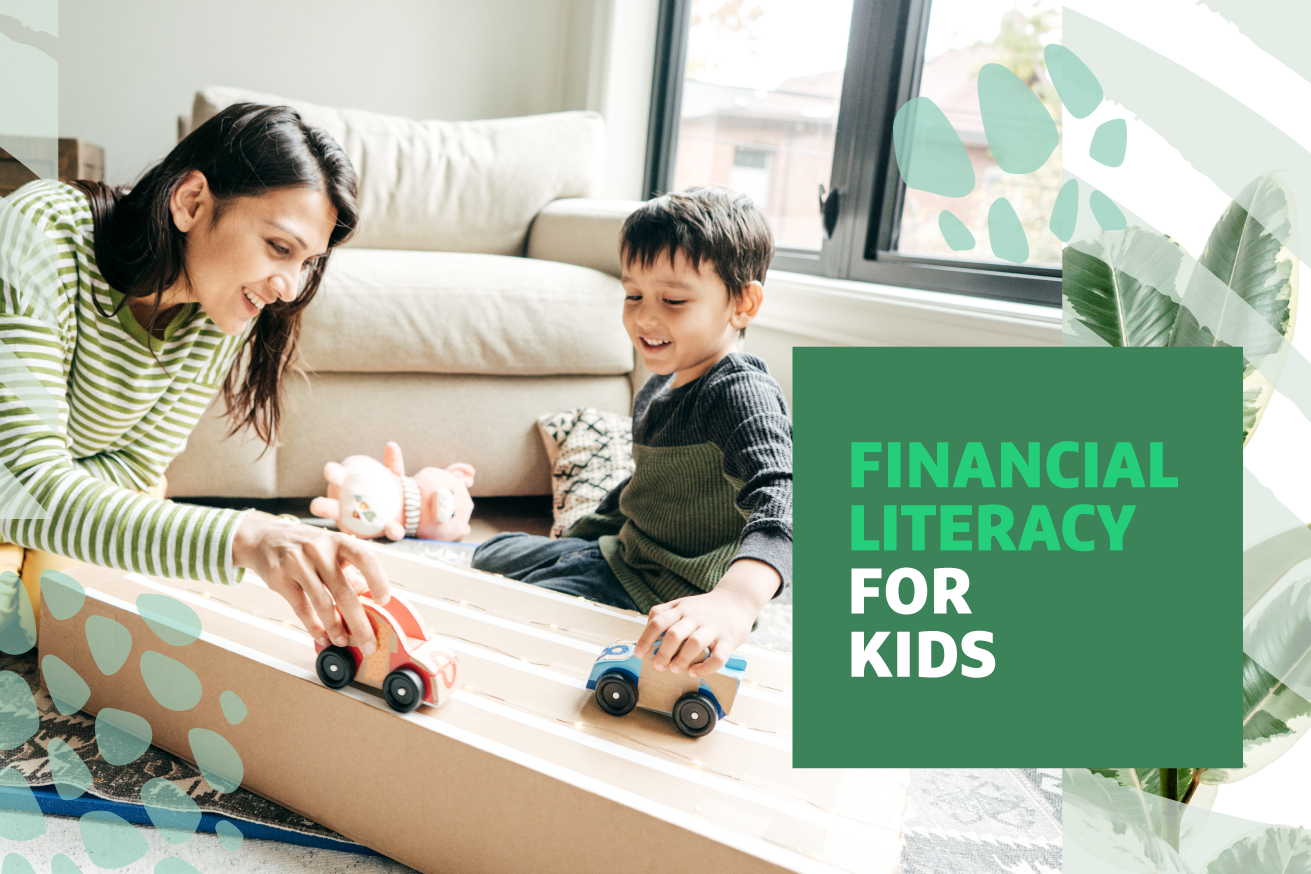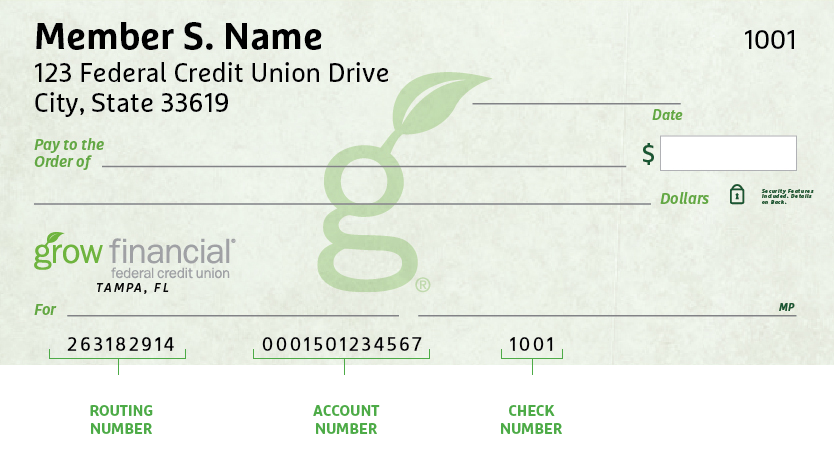- Personal
- Membership
- Membership
- Rates & Fees
- Checking
- Checking
- Personal Loans
- Personal Loans
- Wealth Management
- Investment Services
- Financial Advisors
- Resource Center
- Business

June 8, 2022
Financial Literacy for Kids: Tips from Our Team Members
There’s an age gap when it comes to financial literacy, and young people are at a disadvantage. According to a three-year study from the FINRA Investor Education Foundation, only 34% of American adults could answer at least four of five basic financial literacy questions, and people aged 18- to 34-years-old had the lowest ability to answer the questions — at just 17%. Let’s break the cycle and create a better foundation of financial literacy for kids.
This month, we asked our team members how they teach their own kids about important financial topics and received some excellent advice. Common themes included teaching the value of a dollar in real terms, instilling a savings mindset from a young age, including them in financial conversations about budgeting and credit, and discussing real-world scenarios with them, especially as they enter their teens.
Financial literacy for kids: Advice from our team members
“At seven years old, my daughter is already money conscious. She is aware that in order to have nice things, you must work for them. She sits with me from time to time when completing my monthly budget and asks questions about the allocation of the funds for a better understanding. I hear it a lot, “But why?” Being able to explain to her the importance of being financially conscious allows me to instill something in her that was instilled in me at a young age. You’re never too young to learn the importance of being financially literate.” – Phynedra Little, Branch Supervisor
“My kids get allowance money for doing chores. They do the work, and they get the reward. This allows them to spend the money they earn and helps them learn the value.” – Ryan Jensen, AVP Network Services
“I think it’s important for kids to think about what earning money feels like or what kind of job they may pursue in the future. It starts with understanding a check or a dollar bill is more than just a piece of paper that appears in mom’s wallet. If my daughter wanted to buy something, I encouraged her to save up for it or earn the money herself by doing chores, babysitting, saving a bonus for good grades or depositing birthday money.” – Kim Donahue, Lending Support Specialist
“When I was growing up no one taught me the importance of saving money. That’s why I teach my daughter to save 65% of her allowance, birthday and good grades money, and she knows she always needs to save more than she spends. Hopefully, she will take these good habits into her adulthood.” – Dominique Dearing, Compliance Specialist
“The easiest way I’ve found to make things relatable to my children at a younger age has been to teach them the cost and associated value of items that matter to them. My son’s favorite food item is a cheeseburger. As such, it was one of the first measures that I started bringing up whenever he saw something he wanted to have. ‘How many cheeseburgers does that cost?’ Keeping it relevant to them is key in our household.” – Christopher Flack, MCC Operations Analyst
“I’ve gone over creating a budget with my kids, keeping a whiteboard and scheduling reminders on their phones to remember to pay bills before the due dates, plus why that is important and how that affects their credit. We’ve discussed credit scores and how they are calculated. It’s important that they realize that this is used to calculate everything from insurance rates to how much you may have to pay in down payments for cars, apartments, utilities and so on.” – Maureen Reid, Business Solutions Specialist
“I started with opening savings accounts for them to help them have a place to put their chore, birthday and gift money and showed them interest earnings each month. As they got older and got jobs, they opened checking accounts with me as a joint, and I helped them learn to divide their earnings between checking and savings. With my oldest, I helped him learn to build credit by opening a secured credit card and showing him how minimum payments, available credit, number of open loans and other factors impacted his credit score. After a year of building, he applied for and opened an unsecured rewards card with a higher limit, and I have officially sent him off on his own.” – Tasha Herberger, Business Analyst
“I teach financial literacy for kids through setting financial goals and allowance. We give our children a set of chores to do each week and if they perform them (feed the dog, clean their room, etc.), they get paid an allowance each week. Our kids can spend the money how they like, but we also help them set financial goals. The children each keep a running ledger of their allowance accounts on a piece of paper so that they always know how much money they have and what they have spent their money on in the past.” – Amanda Serrano, Development Supervisor
“I think it’s important they understand the value of a dollar, what things cost and how we have to work hard for things to earn them. We also use an app via Pasco County Schools called Zearn.” – Tami Volkert, Agile Coach
“When my son was 14, I made a deal with him that however much money he saved toward his first car, I would match the amount. This gave him a goal to work toward and incentivized him to save more knowing that the number would essentially ‘double’ when the time came. It also gave me many opportunities to advise him when he did want to spend his money instead of saving it.” – Khenh Vong, Web Application Developer
“Some people shy away from financial topics with younger children like bills, credit cards and other things, but I think that it’s a crucial step in making sure they understand how your paycheck helps you create a budget and how you can use it to better yourself and your future.” – Sarah Greenberg, Market Manager
For more on the topic of financial literacy for kids, read about fun financial education for kids and teens.
Posted In:
How to Find Your Routing & Account Numbers
When you make a payment online, by phone or on a mobile device, you may be asked for our routing number and your checking account number. Credit unions and banks use these numbers to identify accounts and make sure money gets where it’s supposed to be. You’ll also need to provide your routing and checking account numbers for:
- Direct deposits
- Electronic checks
- Military allotments
- Wire transfers
Where to Find Your Routing & Checking Account Numbers
Your personal checks include both our routing number and your account number, as shown on the Grow check example below.

Don’t have a Grow check? No worries.
Visit any Grow store and ask for a Direct Deposit Form. It lists both your routing number and checking account number.
Making a Loan Payment
When it comes to making payments, we try to make it as painless as possible to pay your loan every month. We have several different ways to pay, including convenient online options.
Pay Online
You have two ways to pay online by transferring funds from another bank or credit union.
- Grow Online Banking (Preferred payment method for any loan)
This is the simplest way to pay your loan. You can make one-time payments or set up automatic recurring payments in Grow Online Banking. Once you log in, select “Transfer/Payments” from the menu. If you’re not enrolled in Grow Online Banking yet, you can set up your account in just a few minutes.
Log In
- Debit Card or ACH (Available for auto, personal loans and HELOCs)
Note: ACH and debit card payments are not available for credit cards or most mortgages, except HELOCs.
We accept ACH payments with no additional fees or Mastercard® and Visa® debit cards with a convenience fee of $4.95. To get started with an online ACH or debit card payment, select Pay Now below.
Pay Now
Pay by Mail
You can also pay any Grow loan by check through the mail. Please remember to include your account number and Grow loan number on the check. (For credit card payments, please do not write your 16-digit credit card number on the check, which can cause a delay in processing the payment.)
Address for auto, credit card, personal loan and HELOC payments:
Grow Financial Federal Credit Union
P.O. Box 75466
Chicago, IL 60675-5466Address for personal first or second mortgages and home equity payments:
Grow Financial Federal Credit Union
P.O. Box 11733
Newark, NJ 07101-4733You Are About To Leave GrowFinancial.org
At certain places on this site, there are links to other websites. Grow Financial Federal Credit Union does not endorse, approve, represent, certify or control those external sites. The credit union does not guarantee the accuracy, completeness, efficacy, timeliness or accurate sequencing of the information contained on them. You will not be represented by Grow Financial Federal Credit Union if you enter into a transaction. Privacy and security policies may differ from those practiced by the credit union. Click CONTINUE if you wish to proceed.
